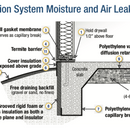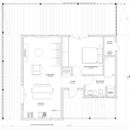Slab/plan review and questions
I’m building a small home in Phoenix AZ with the ideals of a “Pretty Good Home” in mind and an overall goal of net-zero. So I’m trying to adopt as many existing designs as possible — one such being the principles behind the foundation design found in the Dept Energy “Builder’s Guide” to “Hot-Dry” climates (attached). I do have some practical questions about all this, though.
First, I’ve also attached the floor-plan of the house (oriented North), because it matters a lot. Note that there are extensive (concrete) patios covering the entire North and West sides and half of the South. Not shown in the (gravel) driveway covering the entire East wall.
Also critical to my questions is that this house will be built using Universal Design (ADA) principles, as well, and that means zero clearance thresholds throughout. So no steps or bumps or anything anywhere at all in this entire plan.
Given all that:
1. The foundation design for Phoenix recommends rigid foam on the edge of the foundation. I can see this with the “free” half of the South wall and the East wall, but how does this come into play with the extensive area covered by the patios? Does the foam just go up to the underside of the patio? Or does the patio just butt against the foam? And in that case, what happens at the doorways, where there will be a zero-clearance threshold?
2. The foundation plan also has the grade roughly 4″ below the top of the foundation. This will be strictly true only on the half of the South wall that’s traditionally exposed. The rest will either have a patio or a driveway butting against the slab/foundation. How is that handled? Is it okay that “grade” will be flush with the slab (even assuming the patio and driveway are sloped away)?
3. And this set of questions isn’t strictly “green building” related, but it’s related to the rest of my questions. How do foundation/slab plans given to the contractors doing the grading/pouring handle zero-clearance thresholds? Are the patios 1/2″ higher than the slab (to account for the exterior door thresholds and 1/2″ thick tile inside)? Or is the slab just inside of the walls 1/2″ lower, since having the patios higher would result in the patios butting up against the exterior wall, not the foundation? And I guess the shower room would just be 2″ lower than everything else?
As you can see, these are some pretty fundamental and basic questions… but ones that, I guess, are so low-level that I cannot find any answers to them. So in addition to any answers (gratefully accepted!!), I’d also like references to any resources (books, websites, videos, etc) that actually answer questions exactly like this.
GBA Detail Library
A collection of one thousand construction details organized by climate and house part











Replies
Hi Kurt -
I am sure you know this but for others interested in this topic: there are a lot of terms that apply to this sort of design: Universal Design, Accessible Design, ADA-compliant design, even "Visitability."
Also, if you type universal design into the GBA search, quite a few resources on the topic appear: https://www.greenbuildingadvisor.com/?s=universal+design.
I THOUGHT that it would be easy to find US Housing and Urban Development (HUD) resourecs on this type of design, because when I was at the then NAHB Research Center (now Home Innovation Labs), we had a number of research projects at the Research Center funded by HUD. But some websearching just now brought up very little from HUD (with the primary resource from 1996, dating both me and the Research Center's work in this area).
There certainly are architects who specialize in this type of design; Northern Arizona University appears to specialize in Universal Design: https://nau.edu/cdad/commission-on-disability-access-and-design/universal-design/.
Hoping other design-minded GBAers can weigh in as well.
Peter
Kurt
You can taper the top edge of the foam where the patio meets the foundation similar to an insulated basement slab detail. If you want a true thermal break, you can add 1/2 foam above the bevel and make it look like concrete expansion joint.
One detail to watch for is your zero clearance, the thresholds are bellow your concrete, any water that gets there will pool. You need drainage there, if you are using grooved foam board that might be enough, proper weeping tile with gravel would be better.
I would make up a set of dummy thersholds for the contractor taking into account the height of your interior floor finish. Use this for pouring the two slabs. Less chance of messing up the heights.
One thing you might need is a retractable bottom sweep for your entry door. Any standard door sweep over concrete would be destroyed in no time.
These folks give some very nice details for a curbless shower, you would probably need more than 2":
http://blog.buildllc.com/2014/10/curbless-shower-design/
Ah, thanks for the reminder about the door sweep! I'll definitely keep that in mind.
That link for the curbless design is very handy, thank you. I do think 2" should be enough, though, since I'm going with the Schluter Kerdi system and by my measurements, I'm relatively certain that 2" will be ample to fit their panels.
I can't comment to requirements in your area. In Ontario, many of our public designs are done according to Accessibility for Ontarians with Disabilities Act (AODA):
https://en.wikipedia.org/wiki/Accessibility_for_Ontarians_with_Disabilities_Act,_2005
https://www.ontario.ca/laws/statute/05a11
Here is an illustrated guide to them:
https://gaates.org/DOPS/default.php
Note that some municipalities also have their own access standards on top of the provincial ones. Here's, for example, the City of London's Facilities Accessibility Design Standards (FADS) :
https://www.london.ca/city-hall/accessibility/Pages/Facilities-Accessibility-Design-Standards.aspx
https://www.london.ca/city-hall/accessibility/documents/fads_2007_final.pdf
The engineering firm I work for does this kind of work, but we're based out of Ontario and would not be qualified for your area. I hope those links might give you some ideas. If it's any consolation, take solace in that we have to do our designs with frost, salting and heave in mind :)
Hope that helps.
Kurt,
Have you considered placing the rigid insulation to the inside of the foundation wall? Take a look at this foundation detail from the GBA library.
https://www.greenbuildingadvisor.com/cad/detail/slab-on-grade-with-frost-wall-w-1-in-rigid-foam
Perhaps this could help to simplify your design.
Thanks for the pointer, Aaron. Under-slab rigid insulation is pretty much never recommended in Zone 2, where I'm at. In fact, even the edge insulation is only justified if I live in a desert... and I do.
Honestly, BEopt doesn't show any appreciable gain by slab edge insulation in my modeling efforts, so I'm half-tempted to skip that step entirely. It's just that if I do do it, I want to know how to do it right.